Carduus nutans L.
Musk Thistle

Introduced
CC = *
CW = 5
MOC = 36
© SRTurner
Carduus nutans L.Musk Thistle | |
 |
Introduced CC = * CW = 5 MOC = 36 |
© SRTurner |
|
Family - Asteraceae/Cardueae Habit - Coarse biennial or annual forb, from stout taproot. Stems - Erect, to 3 m, glabrous to finely hairy, often branching, winged (from extended leaf bases). Wings with stiff, straw-colored spines along margins.
Leaves - Basal leaves in a rosette, to 60 cm long, oblong, elliptic, or lanceolate, variously lobed, spiny-margined, both surfaces glabrous or pubescent. Stem leaves alternate, to 30 cm, lanceolate to broadly elliptic, variously lobed, the lobes mostly triangular to ovate, spiny-margined, sessile with bases decurrent on stem and forming wings, glabrous or pubescent on both surfaces, sometimes glaucous.
Inflorescence - Solitary terminal heads, usually nodding, 2-7 cm broad, the stalk long and usually relatively naked, usually densely felty-hairy.
Heads - Involucral bracts 15-50 mm long (including the spiny tip), 2-8 mm wide, lanceolate to narrowly ovate (often slightly constricted in the basal 1/2), the outer and median ones spreading to reflexed above the midpoint, greenish purple, with prominent midvein, gradually or more commonly abruptly tapered to a hard, straw-colored or occasionally purple, spiny tip, the surfaces glabrous or felty- to cobwebby-hairy. Inner bracts with spines soft or missing, erect to spreading, purple, with prominent midvein.
Flowers - Ray flowers absent. Disk flowers 18-30 mm long, the corollas 5-lobed, dark pink. Pappus of capillary bristles 13-18 mm long, white. Stamens 5, mostly included. Style exserted well beyond corolla, pinkish to lilac at apex.
Fruits - Achenes glabrous, appearing basally attached, 2.5-4.0 mm long, oblong or slightly narrower at the symmetrical base, somewhat flattened and sometimes slightly 4-angled in cross-section, the tip usually with a slightly raised rim, the surface somewhat shiny, light brown to grayish brown, with numerous longitudinal, darker brown stripes. Flowering - June - October. Habitat - Pastures, prairies, fields, fencerows, disturbed sites, roadsides, railroads. Origin - Native to Eurasia. Lookalikes - Other thistles (Cirsium spp.), though this one is readily distinguished by its general appearance. Other info. - This is an aggressive species which is considered a noxious weed in Missouri as well as throughout most of the continental U.S. In Steyermark's time (1963), it had been recorded from only four counties in the state. Since then it has spread to probably every county, and is a common sight along many highways during the summer. Photographs taken at Flemming Park, Jackson County, MO., 5-13-00 (DETenaglia); also at Marais Temps Clair Conservation Area, St. Charles County, MO, 9-30-2006, Weldon Spring Conservation Area, St. Charles County, MO, 6-9-2007, and near Labadie, Franklin County, MO, 6-7-2022 (SRTurner). |